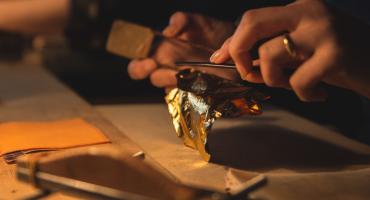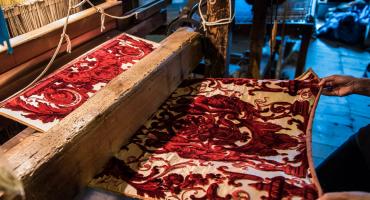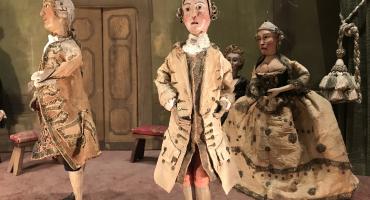Next to the Venice with restaurants offering “touristic menu” at fixed price, cheap-looking shops selling masks and pseudo-Murano glass, there is another Venice which shows its vitality through its traditions and creativity...
of some of the inhabitants, proving wrong the ones who see it as an almost in decline city and in the hands of mass tourism.
In fact, there are borderline artisan worlds (if a border really exists!) in artistic field, some of which, given a long tradition, have become famous and very sought after on international level: for example, the Bevilacqua fabrics, manufactured using original 18th century looms, which faithfully reproduce brocades from Serenissima times and which cover the walls of the Oval Office in the White House (and they have been recently used for some garments in Dolce & Gabbana collection); or visionary masks in papier-mâché by Mondonovo, used for the scene of a secret party in the latest film by Stanley Kubrik, Eyes Wide Shut. And there are also less known but fascinating set-ups, many of which were conceived only few years ago and brought forward by young artisans-artists, as giving evidence of a world that, despite changes in an attitude to social and productive field, has no intention to disappear and, quite the opposite, it’s carving out for itself an increasingly important niche for the ones who refuse the banality of mass produced objects and clothes and go searching for that “aura”, to quote Benjamin, that in the age of “technical reproductibility” only artisan articles still have.
Our recognition starts in the area of S. Polo, and precisely in Campo dei Frari: here, right in front of the main façade of the gothic Church of S.Maria dei Frari, one of the unique two in Venice accomplished in this style (other one is SS. Giovanni e Paolo), there is a shop-laboratory of Laura Pinato, known as “Venetian Zanze”. Zanze is a popular Venetian character, a kind of old hag who wanders around and speaks ill, and in a dialect it’s become a way of saying.
Laura makes papier-mâché masks and wooden objects (boxes, bookmarks…) which she paints inspired by various iconographic sources: from 14th century tarot of Viscounts to medieval miniatures, from Russian icons to ancient geographic maps, up to grotesque characters of Bosch, who are used as models for some masks (even if there are also more traditional masks, those of Commedia dell’Arte).
The reproductions are often accurate but sometimes the original is only a source of inspiration as a starting point for the personal interpretation, like in the case of map of the world achieved as of a two-dimensional map, one of the first portrayals of Earth, which Laura has enriched with her inventions and elements taken from later images. Gilding of wooden objects is done with a metallic leaf called “gold leaf” which then gets burnished using bitumen to give it an “antique” effect; based on this, a drawing with tempera colours is done; then a layer of lacquer is laid all over to polish it.
Continuing towards Campo S. Polo, you’ll come across, a short distance one from another, Atelier Pietro Longhi and laboratory of Alessandro Salvadori.
The Atelier, which takes its name after the Venetian painter who in 18th century portrayed the city’s daily life and its inhabitants (nowadays his works are kept in Museum Correr), was created in 1994 by Francesco Briggi and his wife Anna Maria. Since he was small Francesco has been fascinated by fancy dresses and he started with making carnival costumes for himself and his friends; then, together with his wife, who also shares this passion, he studied in depth the history of fashion and fabrics. As a result, there are splendid dresses, seen to the last detail and made of precious fabrics, where historic research is evident, not only on a model but also on methods of tailoring accomplishment.
Entering their atelier you get thrown into a strange dimension of time where different eras are mixed together: there are doge’s frocks, medieval lady and renaissance courtesan’s dresses and 18th century nobleman’s suit; then there aren’t missing armours and military uniforms from various epochs (some Prussian, Napoleonic and Piedmontese have been manufactured for a historic reconstruction of the Marengo battle). Next to the clothes, in the atelier you can also find shoes, hats, gloves, wigs and various accessories, all handcrafted.
The Briggi couple also collaborate with some Italian and European opera houses (they have recently produced costumes for La Traviata, that was staged at the Opera Theatre in Corfu, Greece); furthermore, they made costumes for the latest film by Squiteri, a remake of “La Venexiana” with Claudia Cardinale, and in 1999, for an American production entitled “Venice Project” they dressed, amongst others, Dennis Hopper and Anna Galiena. Another creation of theirs, a pair of black wings of “fallen angel”, was used for a photographic shooting published in Vogue Jewels.
A bit ahead, on the opposite side, we come across a shop-laboratory of Alessandro Salvadori: his lamps, real and true objects of interior decoration, get inspired by delicate shapes of natural world (flowers, shells, fishes, medusas), or they go by conical shapes of the Fortuny lamps.
Created almost for fun, assembling pieces of various origin, like presents for friends, creations by Alessandro had become increasingly evolved: today, a light and supple structure is in brass, while lampshades are made by sticking various layers of Japanese paper one onto another, then hand painted and occasionally “riddled with holes” to play with the light; often they are then adorned with small Murano pearls.
Beside lamps, Alessandro also creates wooden boxes and frames, where he uses gilding a lot, according to the Venetian tradition of “gilders lacquerers”.
Amongst various inspiration sources, nevertheless always re-interpreted in an absolutely original way, in addition to Fortuny there is Klimt (especially for using of gold and geometric ornaments), Art Nouveau, Gaudi (colours, curved shapes). A small photographic archive documents the destinations where his creations arrived to, once purchased by clients: they go from Madrid to London, from Hong Kong to New York and Paris, naturally passing through many Italian cities.
In Venice his lamps illuminate the nearby Caffè Toppo and Café Noir, a small bar very much frequented by students that can be found close to Campo S. Margherita.
And right between Campo S.Margherita, one of the liveliest places of the city (especially in summer, thanks to high concentration of cafés and restaurants with outdoor tables) and the nearby Campo S.Barnaba, there is a shop-atelier of Gualti, whose real name is Gualtiero Salbego, “experimenter of matter”, as he defines himself.
After training as a ceramist, during which he had never stopped creating various objects using also wood and metals, in 1990 he discovered a material usually used for industrial purposes: it’s to do with synthetic resin, supple and therefore mouldable, that has the transparency and lightness of glass but not its fragility.
Thanks to this material, originally poor but becoming precious with manufacture and combination with glass and crystal details, then hand painted, Gualti starts to create these necklaces, almost small sculptures but which seem endowed with life (in fact, he calls them “creatures”): brooches as leaves or flowers with long threads, necklace as a waterfall of filaments or roots, earrings as anemone vibratiles, which at close look reveal a microcosm rich in details: the “heart” of the jewel is almost always in glass or crystal, that a below layer of silver makes luminous and iridescent like an eye.
All in this innocent and welcoming space seems to be in continuous becoming: even the brick walls within sight, slowly crumbled by time, or the wooden beams on the ceiling, all speak about ceaseless change of natural world.
In addition to necklaces, Gualti has recently started to produce also some accessories, always characterised by his unmistakable style: silk scarves where the fabric remains almost imprisoned by filaments of resin and evening shoes in crepe or satin silk handcrafted following his drawing, often adorned with a small jewel.
Well, slightly turning backwards, near Campo S.Tomà, we come across a shop that reawakens our never buried nostalgia of childhood: Baule blu of Claudia Grano and Silvia Brinis.
Steeping over the threshold we get transported to the grandmother’s attic with overflowing trunks of toys and old sewing machines with a crank (perfectly functioning and in fact, regularly used).
Many years ago, Claudia e Silvia, that used to have an antique shop, going round street markets started to collect old toys: little by little, they started to purchase and restore those broken; then, learning with attention how they were made, they moved onto making their own teddy bears, using high quality materials like mohair wool as well as traditional techniques.
Four years ago they abandoned for good their pervious activity in order to completely dedicate themselves to toys. So, they started to be a part of multicoloured world of toy collecting, which is more complex than what might be believed; at a rough estimate it is split in various sectors: patched animals or soft toys collectors, dolls collectors, tin toys collectors…but within these general subdivisions there are collectors who specialise in one company (i.e. as far as teddy bears are concerned, one of the most famous is Steiff from Germany), in a period (i.e. the twenties), or in a particular subtype (i.e. toy trains or Barbie).
In addition to history books about toys, there are also specialised magazines, especially English ones like “Teddy bear” or “Doll” (that also has an online version www.dollmagazine.com): in fact, this type of collecting, especially with regards to teddy bears, is much more diffused abroad, above all in Great Britain, the United States, Austria and Germany, countries where Silvia and Claudia have got many appreciators and customers.
Well, their teddies are very much appreciated and have participated in various fairs and competitions all over the world, winning numerous awards; one of them then accompanied an Italians scientific expedition in Antarctica as a mascot, from which there is a substantial photographic documentation!
Changing area, or rather crossing the bridge of Rialto and heading towards St Mark’s square, in Calle dei Fuseri, you can find la bottega (this is how Venetians call shops) of Rolando Segalin, a footwear artist rather than a shoemaker: his shoes, entirely handmade using old wooden lasts (which he still modifies to create new models) are some downright works of art and in fact, they are very much appreciated by painters and artists. Rolando Segalin studied in depth the evolution of footwear through time: as well as classic models, he makes shoes that are being inspired by far-off epochs (like poulaine shoes, used by French dignitaries in 14th century, or 18th century shoes with coil heels and buckle), every so often he amuses himself by creating bizarre shoes, like those of Mephistopheles, with a long curved point, or shoe-gondola, or shoe-foot, inspired by a picture by Magritte, that was purchased by Bata Shoe Museum in Toronto together with shoes-stilts, reproduction of those with very high wedges, up to one metre, that were used by Venetian prostitutes in 16th century in order to be seen from faraway when they stood bare-breast on the balconies (there still exists a bridge called “ponte delle tette” – bridge of tits” right for this reason!).
There are numerous customers that have visited his shop and walked out with one of his creations, many actors passing through Venice for Cinema Festival: amongst them Richard Chamberlain (actor in “The Thorn Birds) and, more recently, Tom Hanks.
By this time, there are only few artisans like Segalin but his knowledge continues to be passed on, a strange thing is that this craft, traditionally male, gets now appreciated by women: there are already three female apprentices that have decided to learn from him the art of producing elegant and, at the same time, original shoes.
One of them is Giovanna Zanella, who in the window of her shop, close to Campo S.Lio, exposes some of her creations, fruits of teachings by the one she calls Maestro.
But Giovanna freed herself from the style of Segalin to pursue her completely original road, in syntony with clothes and accessories that constitute the predominant part of her production.
In fact, her creations are an expression of an original research outside fashion standards but still fashionable: wanting to get some points of contact with some well-known names, fashion designers could be quoted: Yohij Yamamoto and, above all, Issey Mijake, that Giovanna worked with (she insists to be defined as artisan and not as designer), having in common the use of simple, almost geometrical forms, but at the same time very soft and with bright colours.
In her shop, where there is also a small laboratory, next to dresses, coats and skirts (rigorously long!), you can see bags, scarves, necklaces and hats of strangest shapes, each one being absolutely unique.
Next to attention to manufacture, creations by Giovanna bear witness to a continuous research also in the field of materials used, always unusual and surprising, and always perfectly in syntony with model’s shapes. Recently, availing herself of the collaboration with one young graduate from the Academy of Fine Arts, she has started to create some picture-dresses, decorated with brush strokes of colour that make all one-off and one different from another.
To conclude this inevitably partial review of Venetian artistic-artisan panorama, I would like to quote the “concept of craft” according to Giovanna Zanella, which in my opinion, can be applied to all the protagonists of this short journey:
“Craft is something that we might already have inside of us and it only needs to be developed. It’s a mysterious drawing, an alchemy that we put together day after day. We think to be learning something that we obviously already know. We only need to work out our knowledge in depth to let a piece of work or an object grow from material that needs to identify itself with our souls. Only then should we be content. To see our creation and expose it in the window of our lives. Time that goes by and gets contemporarily consumed will give us at least the joy of not having wasted too many days and interior tranquillity will be the measure of what we are or will be. Often there is no answer. Only interior sensations difficult even to disclose, but we’ll be in symbiosis with ourselves”.



